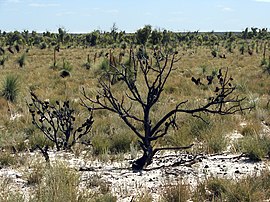Little Desert National Park
|
Little Desert National Park Victoria |
|
|---|---|
|
IUCN category II (national park)
|
|
 |
|
| Nearest town or city | Dimboola |
| Coordinates | 36°36′24″S 141°11′19″E / 36.60667°S 141.18861°ECoordinates: 36°36′24″S 141°11′19″E / 36.60667°S 141.18861°E |
| Established | 1968 |
| Area | 1,326.47 km2 (512.2 sq mi) |
| Managing authorities | Parks Victoria |
| Website | Little Desert National Park |
| See also | Protected areas of Victoria |
The Little Desert National Park is a national park in the Western District of Victoria, Australia. The 132,647-hectare (327,780-acre) national park is situated near Dimboola, approximately 375 kilometres (233 mi) west of Melbourne and extends from the Wimmera River in the east to the South Australian border in the west near Naracoorte.
The Little Desert National Park is divided into three sections: Western Block, Central Block and Eastern Block.
Roads within the park are only accessible by four-wheel-drive vehicles and most tracks in the Central and Western Blocks are closed from 1 June to 31 October or after wet weather because four-wheel-drives can damage the extraordinarily fragile ecosystems under wet conditions. Organised tours are available to the Eastern Block – the oldest and most accessible part of the park – from Melbourne and Dimboola, the nearest town in Victoria.
The park was established in the late 1960s after the Victorian state government announced an intention to subdivide eighty thousand hectares of Crown Land in the region for agriculture. The area in question held a great deal of relatively undisturbed mallee bushland, and was rich in wildflowers and fauna, including a number of threatened species.
The Little Desert receives an annual rainfall of approximately 480 millimetres (19 in), though there is a gradient from 400 millimetres (16 in) in the east to 600 millimetres (24 in) near Naracoorte. This is about the same as the dry farming country surrounding the park, but the Little Desert has very deep sandy soils, which are much lower in essential nutrients than the (only moderately fertile) clay soils used for agriculture. These sandy soils have extraordinarily low contents of available nutrients and hold water very poorly, reducing the availability of water to plants. Thus, farming of the area proved quite impossible until deficiencies of zinc, copper and molybdenum were identified in the 1940s.
...
Wikipedia

